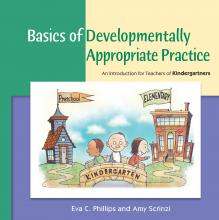Excerpt from Basics of Developmentally Appropriate Practice: An Introduction for Teachers of Kindergartners

Kindergarten teachers are responsible for actively supporting children’s development and learning. There is no magic formula for doing this. Successful teachers use their knowledge and judgment to make decisions about the materials, interactions, and learning experiences likely to be most effective for the group and each individual child.
Below are descriptions of a few teaching strategies that are key to the effective teacher’s repertoire. Certainly others exist, and there are many variations. Moreover, strategies often are used in combination; in a single supportive interaction, for example, a teacher might both acknowledge a child’s actions and give her a cue or challenge (“Marlena, I noticed that you split a set of five cubes into a set of three and a set of two. Is there a different way to split the cubes? How many ways can you find?”).
Ask questions: Move beyond recall questions (“What color is this?”) and ask well-designed and timely questions that encourage the children to explain their thinking, express ideas and actions verbally, describe ideas and strategies in detail, justify decisions made, draw connections, and push them to think in new ways (e.g., “Some of you were shaking your head. Do you have a different idea?”; “What do you think would happen if you tried it again? Do you think you’d see the same thing? Why? Why not?”).
Link the new to the familiar: Help students relate new concepts and information to what they already know and are interested in to help them remember and use what they learn (e.g., “Has something like this ever happened to you before? What happened?” [Dombro, Jablon, & Stetson 2011, 133]; “That’s like the book we read earlier this week. They both have the same ending”).
Listen attentively: Pay close attention to find meaning in what a child says, or doesn’t say, with words and body language. This tells the child that she is cared for, interesting, and considered important. It also allows for genuine opportunities to deeply understand children’s thinking, understanding, and possible misconceptions (e.g., kneeling down to be at the child’s level, the teacher says, “Maria, I see that you have finished painting. Tell me about your work”; “Your face tells me that you are frustrated. How can I help?”) (see Dombro, Jablon, & Stetson 2011).
Offer choices: Strategically offer choices to children in order for them to practice decision making and become more involved in their learning—thus exerting more effort in their work—while boosting social and cognitive abilities. Choices also enable students to feel empowered, become more independent, and gain ownership over their work (Gronlund 2010) (e.g., “There are three activities to complete today. Think about which one you plan to do first. What will be your second choice? What will be your third choice?”; “Decide if you would like to work with a partner or if you would like to work by yourself today”).
Support reflection: Provide opportunities for children to reflect on their actions and their thoughts and integrate new information into what is already known. When children engage in reflective thought, they consider new information and develop understanding and reasoned thinking (e.g., “Think about why you think this is true”; “I wonder why . . . ”; “What do you think will happen when you pour that into this container? Why do you think so?”) (Zambo & Zambo 2008).
Use rich vocabulary: Introduce complex and different words to children to expand their vocabularies, a link to school success (Dombro, Jablon, & Stetson 2011) (e.g., “You’re curious about that word, aren’t you? I’ll read that part again. Do you have any guesses about what it means?” (116); “I think that’s an interesting word, too. Shall we add that word to our chart?”).
Create or add challenge: Generate a problem or add difficulty to a task or step so that it is a bit beyond what children have already mastered (e.g., once a child counts up to five items accurately, begin engaging him in counting sets of six to eight). Or reduce the challenge to meet children where they are (e.g., if a child is unable to count a set of five items accurately, give him a smaller amount, such as three).
Encourage: Offer comments or nonverbal actions that promote the child’s persistence and effort (e.g., “That wasn’t easy, but you kept trying different strategies. You really persevered”), rather than giving the child non-specific evaluative praise (“Good job, Ben”).
Foster dialogue and communication: Extend children’s language awareness, understanding, and thinking by engaging them in conversations (see Dombro, Jablon, & Stetson 2011). Also, provide opportunities for students to interact with one another and exchange ideas, predictions, and outcomes while applying knowledge and skills as ideas are explored and problems are solved (e.g., “Tell me more about that”; “With your partner, investigate the different seeds. Tell each other what you see”; “Maria and Jose are thinking that the plant will grow if we do what Jacob and Shakila suggested. What do the rest of you think? Do you think Jacob and Shakila’s idea will work, or do you have a different idea?”).
From Basics of Developmentally Appropriate Practice: An Introduction for Teachers of Kindergartners, by E.C. Phillips & A. Scrinzi. Copyright © 2013 by the National Association for the Education of Young Children.
Learn more about this book
Resources
Recommendations
For Authors & Photographers
Catalog
Webinars
NAEYC Books List
